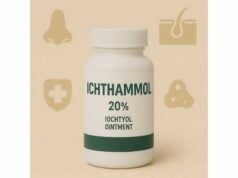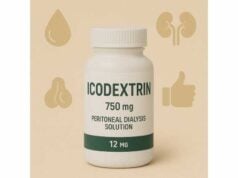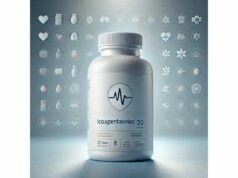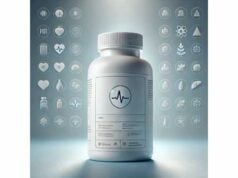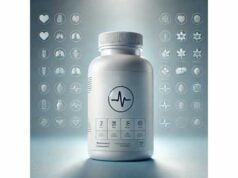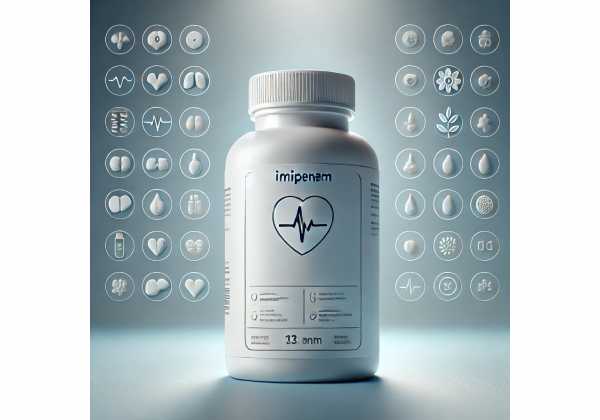
Imipenem is a hospital-grade, broad-spectrum carbapenem antibiotic given by intravenous infusion—nearly always co-formulated with cilastatin, which protects imipenem from rapid breakdown in the kidneys. Clinicians rely on it for severe, polymicrobial, or resistant infections when narrower options are unlikely to work. Imipenem targets cell-wall synthesis, remains active against many Gram-positives, Gram-negatives (including Pseudomonas aeruginosa in many regions), and anaerobes, and is often reserved by stewardship teams to preserve its usefulness. In adults with normal renal function, common regimens are 500 mg every 6 hours or 1,000 mg every 8 hours (equal amounts of cilastatin are co-administered). Because efficacy and toxicity are tightly linked to renal clearance, dosing is adjusted as creatinine clearance declines. This guide explains what imipenem can and cannot treat, how it compares with related agents, how to dose and infuse it safely, pitfalls to avoid, side effects to monitor, and how evidence and guidelines position it in modern care.
Core Points
- Broad-spectrum IV carbapenem (co-formulated with cilastatin) for severe polymicrobial or resistant infections when narrower agents are unsuitable.
- Typical adult dosing with normal renal function: 500 mg q6h or 1,000 mg q8h (infuse 20–60 minutes depending on dose); renally adjust below 90 mL/min.
- Key cautions: seizure risk increases with renal impairment or CNS disease; carbapenems can lower valproate levels; monitor for hypersensitivity.
- Avoid empiric use when narrower therapy will cover; reserve for proven or strongly suspected indications guided by cultures and local resistance data.
Table of Contents
- What is imipenem and how does it work?
- When to use imipenem and when to choose alternatives
- Dosing, infusion methods, and renal adjustment
- Common pitfalls, compatibility, and troubleshooting
- Side effects, interactions, and who should avoid it
- Evidence, outcomes, and stewardship positioning
What is imipenem and how does it work?
Imipenem is the first widely used carbapenem antibiotic. Like other β-lactams, it binds penicillin-binding proteins and blocks bacterial cell-wall synthesis, leading to rapid bactericidal activity. Its spectrum spans:
- Gram-positive aerobes: includes MSSA and streptococci; activity against Enterococcus faecalis is variable and dose-dependent.
- Gram-negative aerobes: including many Enterobacterales (ESBL producers remain susceptible in many settings), and often P. aeruginosa (local patterns apply).
- Anaerobes: robust activity (e.g., Bacteroides fragilis group).
Imipenem is inactivated in the renal tubule by dehydropeptidase-I (DHP-I). Cilastatin inhibits DHP-I, preserving active imipenem and limiting nephrotoxic metabolites. Co-administration is therefore standard: commercial vials or bags supply imipenem/cilastatin in a 1:1 ratio.
Pharmacodynamic goal. Like other β-lactams, imipenem efficacy correlates with the time free drug concentrations stay above the pathogen’s MIC (fT>MIC). Practical implications:
- Divide the total daily dose into q6–8h dosing or use prolonged/extended infusions to increase fT>MIC for organisms with higher MICs within the susceptible range.
- Adjust the regimen promptly with renal impairment to avoid toxicity while preserving exposure.
Limits of activity. Imipenem is inactive against organisms that produce certain carbapenemases (e.g., KPC, NDM, OXA-48-like), MRSA, Stenotrophomonas maltophilia, atypical intracellular pathogens, and most fungi/viruses. For difficult carbapenem-resistant infections, imipenem/cilastatin/relebactam may be considered (distinct product and labeling), depending on the specific β-lactamase mechanisms and local susceptibility.
Clinical formulation notes.
- Supplied as powder for reconstitution and IV infusion, commonly 500 mg/500 mg or 1,000 mg/1,000 mg vials (imipenem/cilastatin).
- Infuse 20–30 minutes for ≤500 mg doses, 40–60 minutes for >500 mg doses.
- Maximum recommended total imipenem 4 g/day in adults with normal renal function.
When to use imipenem and when to choose alternatives
Appropriate roles (examples, guided by local epidemiology and individual risk):
- Complicated intra-abdominal infections (cIAI) when broad empiric coverage is needed for mixed aerobic/anaerobic flora, especially with prior cephalosporin exposure or ESBL risk.
- Complicated urinary tract infections (cUTI)/pyelonephritis with prior ESBL colonization/infection or in critically ill patients pending cultures.
- Hospital-acquired or ventilator-associated pneumonia (HAP/VAP) where risk of resistant Gram-negatives is high and antipseudomonal β-lactams with narrower spectra are unsuitable or failing.
- Severe diabetic foot or necrotizing soft tissue infection as part of initial broad coverage (plus agents for MRSA and toxin suppression when indicated).
- Bacteremia from suspected ESBL-producing Enterobacterales, after discussion with stewardship/ID if narrower carbapenems (e.g., ertapenem for non-Pseudomonas risk) are inappropriate.
When an alternative is better:
- Low-risk community infections with predictable pathogens (e.g., routine community pyelonephritis, non-severe biliary infection): choose narrower agents once susceptibilities are known or local data support them.
- MRSA concerns: add or use MRSA-active agents (e.g., vancomycin, linezolid); imipenem has no MRSA activity.
- Carbapenemase producers (CRE) or DTR P. aeruginosa: rely on mechanism-matched agents (e.g., ceftazidime-avibactam, meropenem-vaborbactam, cefiderocol, or imipenem/cilastatin/relebactam when appropriate).
- Anaerobe-only infections (e.g., oral/odontogenic without Gram-negative risk): metronidazole or amoxicillin-clavulanate may suffice.
Empiric → targeted. Start broad only when necessary; de-escalate within 24–72 hours as cultures/MICs return. Stewardship improves outcomes, reduces resistance pressure, and lowers cost and toxicity.
Special populations:
- Neutropenia or transplant: carbapenems are valuable for high-risk febrile neutropenia or MDR colonization; involve oncology/ID to tailor antipseudomonal and anti-MRSA components.
- Renal replacement therapy: imipenem/cilastatin dosing requires careful adjustment and post-hemodialysis timing (see dosing section).
Bottom line: imipenem is a powerful, reserved tool. Use it when the probability of resistant or mixed pathogens is high, and switch to a narrower regimen as soon as the data allow.
Dosing, infusion methods, and renal adjustment
Standard adult dosing (normal renal function, ≥90 mL/min creatinine clearance):
- 500 mg IV every 6 hours or 1,000 mg IV every 8 hours.
- For organisms with intermediate susceptibility (higher MIC within the susceptible/intermediate range), some protocols use 1,000 mg every 6 hours to maximize exposure (stay within the ≤4 g/day imipenem total).
Infusion duration (important for tolerability):
- ≤500 mg doses: infuse over 20–30 minutes.
- >500 mg doses: infuse over 40–60 minutes.
- If nausea occurs during infusion, slow the rate. Prolonged/extended infusions (e.g., 3 hours) may be used in selected cases to increase fT>MIC; follow institutional guidance.
Renal adjustment (adult):
- Dose reduce when creatinine clearance <90 mL/min. Representative label-aligned examples:
- CLcr 60–89 mL/min: 400 mg q6h or 500 mg q6h depending on target exposure.
- CLcr 30–59 mL/min: 300–500 mg with extended intervals (e.g., 500 mg q8h or 300 mg q6h).
- CLcr 15–29 mL/min: 200–500 mg with longer intervals (e.g., 500 mg q12h or 200 mg q6h).
- CLcr <15 mL/min: avoid unless hemodialysis is planned within 48 hours; dose after dialysis and time subsequent doses from the end of the session.
- Always follow your institution’s dosing table tied to the current label, and re-check kidney function frequently in unstable patients.
Pediatrics (non-CNS infections): weight-based regimens (e.g., 15–25 mg/kg q6h, not to exceed 4 g/day of imipenem), with special caution in neonates/young infants and in any child with renal impairment. CNS infections are not recommended due to seizure risk.
Preparation and stability essentials:
- Reconstitute vials with an appropriate diluent, transfer to ~100 mL infusion solution, and infuse promptly.
- Room-temperature stability is ~4 hours post-reconstitution; under refrigeration (~5°C) ~24 hours (do not freeze).
- Do not mix in the same bag with other antibiotics; use separate lines or flush between infusions if using the same access.
Therapeutic drug monitoring (TDM): not routinely available for imipenem, but β-lactam TDM programs (where present) can help optimize exposure in critical illness, obesity, or augmented renal clearance.
Duration of therapy: driven by source control and clinical response (e.g., 4–7 days for many cUTI/cIAI after adequate source control; 7–14 days for HAP/VAP, individualized). Coordinate with stewardship/ID.
Common pitfalls, compatibility, and troubleshooting
Pitfall 1: Under-adjusting for renal function.
Seizure risk rises as imipenem accumulates—particularly when CLcr ≤30 mL/min. Build renal checks into daily order sets for ICU patients, and adjust promptly for acute kidney injury or recovery.
Pitfall 2: Treating carbapenemase producers with imipenem/cilastatin alone.
If KPC, NDM, or OXA-48-like enzymes are present, imipenem alone will likely fail. Use mechanism-matched agents (e.g., ceftazidime-avibactam for KPC; cefiderocol; or imipenem/cilastatin/relebactam for certain DTR P. aeruginosa or carbapenem-resistant Enterobacterales), guided by susceptibility.
Pitfall 3: Overly short infusions for higher MIC targets.
For pathogens with MICs near the susceptibility breakpoint, extended infusions or q6h dosing can improve fT>MIC. Use institutional protocols to implement safely.
Pitfall 4: Inadvertent drug interactions.
Carbapenems can lower serum valproate/divalproex concentrations, risking breakthrough seizures. If a carbapenem is indispensable, plan antiepileptic bridging or an alternative antibacterial strategy. Watch for additive nephrotoxicity with other renally cleared agents.
Pitfall 5: Incompatibilities and line issues.
Do not Y-site mix with other β-lactams or aminoglycosides unless explicitly validated; flush between sequential infusions. Confirm line patency—extravasation increases local irritation.
Practical troubleshooting
- Infusion-related nausea: slow infusion; premedication is rarely needed.
- Persistent fevers on therapy: reassess source control, susceptibility, drug exposure (renal function, infusion times), and superinfections (e.g., C. difficile).
- Rash versus infusion reaction: most β-lactam rashes are mild; true anaphylaxis is rare but mandates cessation and allergy evaluation.
Switching and de-escalation
- Once cultures/molecular diagnostics finalize, step down to a narrower IV or oral agent (e.g., ceftriaxone, piperacillin-tazobactam, fluoroquinolone, TMP-SMX, amoxicillin-clavulanate) if appropriate.
- For uncomplicated Gram-negative bacteremia with source control and clinical stability, short-course strategies and early IV-to-PO transition reduce length of stay without compromising outcomes when criteria are met.
Side effects, interactions, and who should avoid it
Common adverse effects
- GI: nausea, vomiting, diarrhea.
- Infusion site reactions: phlebitis, discomfort.
- Skin: rash, pruritus.
- Laboratory: transient transaminase elevations.
Serious but less common
- Seizures: risk increases with renal impairment, pre-existing CNS disease, high doses, and concomitant valproate withdrawal from the interaction. Maintain label-aligned renal dosing, avoid exceeding 4 g/day of imipenem in adults with normal renal function, and consider alternatives in high-risk patients.
- Hypersensitivity: cross-reactivity with other β-lactams is possible; a detailed allergy history and, when indicated, allergy consultation are advised.
- Clostridioides difficile infection: broad anaerobic coverage disrupts the microbiome; monitor for new-onset diarrhea.
Key drug interactions
- Valproic acid/divalproex: carbapenems can markedly reduce serum valproate, precipitating seizures; avoid combination or provide alternative antiepileptic coverage and close monitoring.
- Probenecid and other tubular secretion inhibitors: may alter imipenem/cilastatin handling; check local interaction resources.
- Nephrotoxic agents (e.g., high-dose vancomycin, aminoglycosides): monitor renal function and drug levels where applicable.
Who should avoid or use with caution
- Severe β-lactam allergy/anaphylaxis history: avoid; if life-threatening infection mandates, consult allergy/ID for desensitization or alternatives.
- CNS disorders or seizure history: prefer alternatives when feasible; if required, optimize renal dosing and consider antiepileptic management plans.
- Advanced renal impairment (CLcr <15 mL/min): avoid unless hemodialysis is planned and dosing can be timed post-dialysis with close monitoring.
- Pregnancy and lactation: no established teratogenic signal in humans, but use only when clearly needed and safer alternatives are unsuitable; discuss risks/benefits.
Patient counseling essentials (for bedside teams)
- Explain why a carbapenem is chosen (severity/resistance risk).
- Set expectations about infusion time, potential GI upset, and the plan to de-escalate if possible.
- Instruct to report new neurologic symptoms, severe diarrhea, rash, or signs of an allergic reaction immediately.
Evidence, outcomes, and stewardship positioning
Clinical indications and label. The FDA label for imipenem/cilastatin includes lower respiratory tract infections, urinary tract infections (complicated and uncomplicated), intra-abdominal infections, gynecologic infections, bacteremia, bone and joint infections, skin/skin-structure infections, and endocarditis—reflecting the drug’s broad historical use. Modern practice narrows these indications via susceptibility-driven care and stewardship programs.
Comparative efficacy. Across cUTI, cIAI, and HAP/VAP, carbapenems perform well when pathogens are susceptible, with outcomes influenced more by source control, patient severity, and time to appropriate therapy than by small differences among carbapenems. For ESBL-producing Enterobacterales bacteremia, randomized and observational data support carbapenems as preferred definitive therapy over piperacillin-tazobactam when high-inoculum infections are present, with local susceptibility guiding agent selection.
Safety profile in context. Meta-analyses suggest the absolute risk of carbapenem-associated seizures is low, though imipenem shows a higher signal than some peers; the risk remains strongly tied to renal overdosing and CNS comorbidity. With modern dosing vigilance, events are uncommon.
Where newer agents fit. For carbapenem-resistant pathogens or difficult-to-treat P. aeruginosa, mechanism-targeted β-lactam/β-lactamase inhibitor combinations (e.g., imipenem/cilastatin/relebactam) expand options, often with improved safety and PK/PD profiles against specific resistance mechanisms. Choice hinges on local resistance genes and in vitro susceptibility.
Stewardship takeaways
- Reserve imipenem for probable resistant/mixed infections or when patients are critically ill and narrower empiric choices carry unacceptable failure risk.
- De-escalate promptly as cultures return; consider shorter courses with source control.
- Prefer extended infusions or q6h dosing for higher MIC targets within the susceptible range, aligned with institutional protocols.
- Track renal function daily to avoid toxicity and to maintain target exposure.
In short: imipenem remains a cornerstone broad-spectrum agent. Used thoughtfully—at the right dose, duration, and indication—it delivers reliable coverage while minimizing harm and resistance pressure.
References
- IMIPENEM AND CILASTATIN injection, powder, for solution 2024 (Label)
- IDSA 2024 Guidance on the Treatment of Antimicrobial Resistant Gram-Negative Infections 2024 (Guidance)
- Nephroprotective Effects of Cilastatin in People at Risk of Acute Kidney Injury: A Systematic Review and Meta-analysis 2024 (Systematic Review)
- The risk of seizures among the carbapenems: a meta-analysis 2014 (Systematic Review)
- Label: RECARBRIO — imipenem anhydrous, cilastatin, and relebactam 2024 (Label)
Medical Disclaimer
This guide is for education and does not replace professional medical advice, diagnosis, or treatment. Imipenem (with cilastatin) is a prescription intravenous antibiotic that should be selected, dosed, and monitored by qualified clinicians based on cultures, local resistance patterns, organ function, and individual risks. Seek urgent care for signs of severe allergy, new neurologic symptoms, severe diarrhea, or clinical worsening. Always follow your hospital’s protocols and infectious-disease guidance.
If you found this article helpful, please consider sharing it on Facebook, X (formerly Twitter), or your preferred platform, and follow us for more evidence-based clinical summaries. Your support helps us keep producing high-quality content for healthcare professionals and patients.

